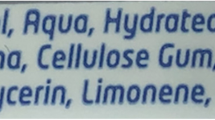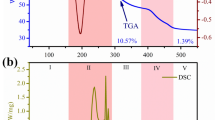Abstract
Electrochemical corrosion has four elements (anode, cathode, a metallic path, and electrolyte). For non-metals, the first three elements are absent. Thus, corrosion is exclusive used for metals and deterioration for non-metals. Microbiologically influenced corrosion (MIC) applies to metals and microbiologically influenced deterioration (MID) applies to non-metals such as polymers and composites. In this article, a four-step algorithm/guide to prepare root cause analysis reports for MIC/MID cases is presented. By applying this algorithm, making syntax errors in such analyses will become as low as possible.









Similar content being viewed by others
Notes
In Reference 6, We proposed the Greek term “Temenos” instead of biofilm.
Although there are methods that can be used in the field (the so-called quick field tests (e.g., BART®) or even a limited number of electrochemical techniques may also be applied on filed applications.
Some similarities with standards such as TM)194 may be felt however the formats presented here is shorter and more straight in engineering terms.
It does not matter if the bottle is a glass or plastic bottle As per standards NACE Standard TM0194-2004 section 2.2.1 and NACE Standard TM0106-2016 section 5.1.1 a (NACE TM0194-2014 is silent about this issue. However, due to the weight of the glass and also that glass is a fragile material, based on our experience we can recommend using plastic bottles.
References
M. Dubiel, C.H. Hsu, C.C. Chien, F. Mansfeld, D.K. Newman, Microbial iron respiration can protect steel from corrosion. Appl. Environ. Microbiol. 68(3), 1440–1445 (2002)
P. Parthipan, J. Narenkumar, P. Elumalai et al., Neem extract as a green inhibitor formicrobiologically influenced corrosion of carbon steel API 5LX in a hypersaline environment. J. Molecul. Liq. 240, 121–127 (2017)
B.J. Little, D.J. Blackwood, J. Hinks, F.M. Lauro, E. Marsili, A. Okamoto, S.A. Rice, S.A. Wade, H.-C. Flemming, Microbially influenced corrosion—Any progress? Corros. Sci. 170, 108641 (2020)
R. Javaherdashti, MIC myths: avoiding common pitfalls in the practice of hydrotesting and likelihood of Microbial induced corrosion”, Corrosion Management, pp: 11–14, January/February 2009.
B.J. Little, P. Wagner, Myths related to microbiologically influenced corrosion. Mater. Perform. 36(6), 40–44 (1997)
R. Javaherdashti, Some thoughts about misconceptions surrounding the term ‘biofilm’. Corr. Eng. Sci. Technol. (2020). https://doi.org/10.1080/1478422X.2020.1774106
D.G. Enos, S.R. Taylor, Influence of sulfate-reducing bacteria on alloy 625 and austenitic stainless-steel weldments. Corrosion. 52(11), 831–842 (1996)
R. Javaherdashti, A pathological mini-atlas of microbiologically influenced corrosion and deterioration (MIC/MID) cases. (Trans Tech Publications, Switzerland, 2020)
M. Yazdi, F. Khan, R. Abbassi, N. Quddus, H. Castaneda-Lopez, A review of risk-based decision-making models for microbiologically influenced corrosion (MIC) in offshore pipelines. Reliabil. Eng. Syst. Safety. 223, 108474 (2022)
R. Javaherdashti, Microbiologically influenced corrosion-an engineering insight, 2nd edn. (Springer, London, 2017)
R. Javaherdashti, “MIC and Cracking of Mild and Stainless Steels”, (PhD Thesis). VDM Publishing, Germany, 2010
Author information
Authors and Affiliations
Corresponding author
Additional information
Publisher's Note
Springer Nature remains neutral with regard to jurisdictional claims in published maps and institutional affiliations.
Rights and permissions
Springer Nature or its licensor (e.g. a society or other partner) holds exclusive rights to this article under a publishing agreement with the author(s) or other rightsholder(s); author self-archiving of the accepted manuscript version of this article is solely governed by the terms of such publishing agreement and applicable law.
About this article
Cite this article
Javaherdashti, R. Root Cause Analysis Reports for MIC/MID Cases: Practical Tips. J Fail. Anal. and Preven. 23, 2298–2304 (2023). https://doi.org/10.1007/s11668-023-01806-5
Received:
Accepted:
Published:
Issue Date:
DOI: https://doi.org/10.1007/s11668-023-01806-5




